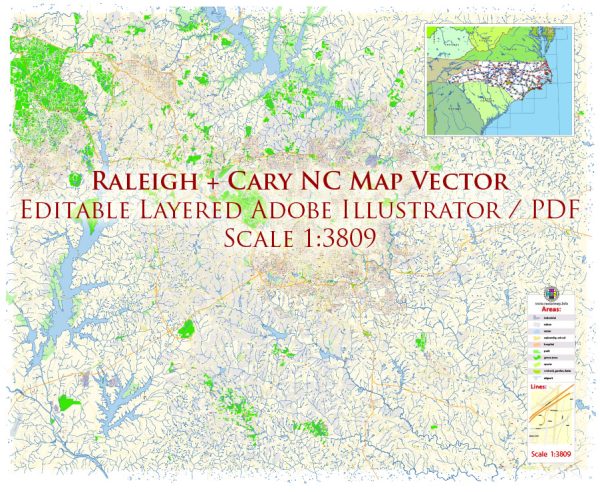The urban development history of Raleigh, Cary, and Durham in North Carolina reflects the broader trends in American urbanization, with each city having its own unique story.
- Raleigh:
- Raleigh, the capital of North Carolina, was planned and established in 1792 as the state capital. The city was named after Sir Walter Raleigh, who was instrumental in the colonization of the Roanoke Colony, an early English settlement in present-day North Carolina. The city’s central location within the state was a strategic choice for the capital.
- Raleigh’s early growth was influenced by its role as a political and administrative center. The construction of the State Capitol building and other government structures contributed to the city’s development.
- Over the years, Raleigh expanded beyond its governmental functions and evolved into a hub for education, technology, and research. The presence of institutions like North Carolina State University has played a significant role in shaping Raleigh as a center for innovation.
- The Research Triangle Park (RTP), located between Raleigh, Durham, and Chapel Hill, has been a major catalyst for economic growth in the region. Established in 1959, RTP has attracted numerous high-tech companies and research institutions, contributing to the area’s reputation as a technology and research hub.
- Cary:
- Cary, originally known as Bradford’s Ordinary, was founded in 1750. It began as a small rural community and remained relatively small until the mid-20th century.
- Cary experienced significant growth in the latter half of the 20th century, transforming from a suburb to a thriving town. The expansion of the Research Triangle Park and the general economic prosperity of the region contributed to Cary’s growth.
- Known for its planned development, Cary has carefully managed its growth, focusing on creating a high quality of life for residents. The town has attractive parks, green spaces, and a well-planned infrastructure.
- Cary’s growth is also tied to its proximity to major highways and its appeal as a residential community for those working in the Research Triangle area.
- Durham:
- Durham has a rich history, with its roots in the tobacco industry. The city was founded in 1853 as a stop on the North Carolina Railroad and grew rapidly due to the tobacco trade.
- The American Tobacco Company, based in Durham, was a major player in the industry. The city’s skyline was dominated by tobacco warehouses and factories.
- Over the years, Durham has diversified its economy, with the decline of the tobacco industry. The city is known for its healthcare and research institutions, including Duke University and the Duke University Medical Center.
- The revitalization of downtown Durham in recent years has seen the adaptive reuse of historic tobacco warehouses into trendy restaurants, shops, and residential spaces. This transformation reflects a broader trend of urban renewal and the creative repurposing of industrial areas.
In summary, Raleigh, Cary, and Durham have distinct histories shaped by their origins, economic drivers, and responses to broader regional trends. While Raleigh is the political and educational center, Cary is a planned suburban community, and Durham has evolved from its tobacco roots to become a diverse and vibrant city. The interconnectedness of these cities in the Research Triangle region has contributed to their collective success and growth.


 Author: Kirill Shrayber, Ph.D.
Author: Kirill Shrayber, Ph.D.